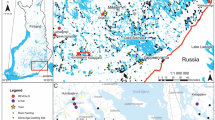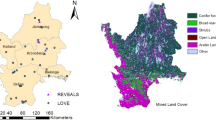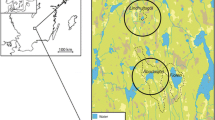Abstract
Information on past land cover in terms of absolute areas of different landscape units (forest, open land, pasture land, cultivated land, etc.) at local to regional scales is needed to test hypotheses and answer questions related to climate change (e.g. feedbacks effects of land-cover change), archaeological research, and nature conservancy (e.g. management strategy). The palaeoecological technique best suited to achieve quantitative reconstruction of past vegetation is pollen analysis. A simulation approach developed by Sugita (the computer model POLLSCAPE) which uses models based on the theory of pollen analysis is presented together with examples of application. POLLSCAPE has been adopted as the central tool for POLLANDCAL (POLlen/LANdscape CALibration), an international research network focusing on this topic. The theory behind models of the pollen–vegetation relationship and POLLSCAPE is reviewed. The two model outputs which receive greatest attention in this paper are the relevant source area of pollen (RSAP) and pollen loading in mires and lakes. Six examples of application of POLLSCAPE are presented, each of which explores a possible use of the POLLANDCAL tools and a means of validating or evaluating the models with empirical data. The landscape and vegetation factors influencing the size of the RSAP, the importance of pollen productivity estimates (PPEs) for the model outputs, the detection of small and rare patches of plant taxa in pollen records, and quantitative reconstructions of past vegetation and landscapes are discussed on the basis of these examples. The simulation approach is seen to be useful both for exploring different vegetation/landscape scenarios and for refuting hypotheses.

















Similar content being viewed by others
References
Andersen ST (1970) The relative pollen productivity and representation of north European trees, and correction factors for tree pollen spectra. Dan Geologiske Undersøgelse II 96:1–99
Andersen ST (1973) The differential pollen productivity of trees and its significance for the interpretation of pollen diagram from a forested region. In: Birks HJB, West RG (eds) Quaternary plant ecology. Blackwell, Oxford, pp 109–116
Anderson NJ, Bugmann H, Dearing JA, Gaillard M-J (2006) Linking palaeoenvironmental data and models to understand the past and to predict the future. Trends Ecol Evol 21:696–704
Bradshaw RHW, Webb TIII (1985) Relationship between contemporary pollen and vegetation data from Wisconsin and Michigan, USA. Ecology 66:721–737
Broström A (2002) Estimating source area of pollen and pollen productivity in cultural landscapes of southern Sweden—developing a palynological tool for quantifying past plant cover. Ph.D. thesis, Department of Quaternary Geology, Lund University, Lund
Broström A, Gaillard M-J, Ihse M, Odgaard B (1998) Pollen-landscape relationships in modern analogues of ancient cultural landscapes in southern Sweden—a first step towards quantification of vegetation openness in the past. Veget Hist Archaeobot 7:189–201
Broström A, Sugita S, Gaillard M-J (2004) Pollen productivity estimates for reconstruction of past vegetation cover in the cultural landscape of Southern Sweden. Holocene 14:371–384
Broström A, Sugita S, Gaillard M-J (2005) Estimating the spatial scale of pollen dispersal in the cultural landscape of southern Sweden. Holocene 15:252–262
Broström A, Nielsen B, Gaillard M-J, Hjelle K, Mazier F, Binney H, Bunting J, Fyfe R, Meltsov V, Poska A, Räsänen S, Soepboer W, von Stedingk H, Suutari H, Sugita S (2008) Pollen productivity estimates of key European plant taxa for quantitative reconstruction of past vegetation: a review. Veget Hist Archaeobot 17. doi:10.1007/s00334-008-0148-8
Bunting J, Middleton R (2005) Modelling pollen dispersal and deposition using HUMPOL software, including simulating windroses and irregular lakes. Rev Palaeobot Palynol 134:185–196
Bunting J, Gaillard M-J, Sugita S, Middleton R, Broström A (2004) Vegetation structure and pollen source area. Holocene 14:651–660
Bunting MJ, Armitage R, Binney HA, Waller M (2005) Estimates of “relative pollen productivity” and “relevant source area of pollen” for major tree taxa in two Norfolk (UK) woodlands. Holocene 15:459–465
Bunting MJ, Middleton R, Twiddle CL (2007) Wetland records of a coastal cultural landscape in north-west Scotland: an application of the multiple scenario approach to landscape reconstruction. In: Barber B, Clark C, Cressey M, Crone A, Hale A, Henderson J, Housley R, Sands R, Sheridan A (eds) Archaeology from the Wetlands: recent perspectives (WARP Occasional Paper 18). Society of Antiquaries of Scotland, Edinburgh, pp 109–117
Bunting MJ, Twiddle CL, Middleton R (2008) Reconstructing past vegetation in mountain areas from pollen data: application of models of pollen dispersal and deposition. Palaeogeogr Palaeoclim Palaeoecol 259:77–91
Calcote R (1995) Pollen source area and pollen productivity: evidence from forest hollows. J Ecol 83:591–602
Caseldine C, Fyfe R (2006) A modelling approach to locating and characterising elm decline/landnam landscapes. Quatern Sci Rev 25:632–644
Caseldine C, Fyfe R, Langdon C, Thompson G (2007a) Simulating the nature of vegetation communities at the opening of the Neolithic on Achill Island, Co. Mayo, Ireland—the potential role of models of pollen dispersal and deposition. Rev Palaeobot Palynol 144:135–144
Caseldine C, Fyfe R, Hjelle K (2007b) Pollen modelling, palaeoecology and archaeology—virtualisation and/or visualisation of the past? Veget Hist Archaeobot 17. doi:10.1007/s00334-007-0093-y
Davis MB (1963) On the theory of pollen analysis. Am J Sci 261:897–912
Davis MB (1966) Determination of absolute pollen frequency. Ecology 47:310–311
Davis MB (1968) Pollen grains in lake sediments: redeposition caused by seasonal water circulation. Science 162:769–799
Davis MB (2000) Palynology after Y2K—understanding the source area of pollen in sediments. Ann Rev Earth Plan Sci 28:1–18
Davis MB, Brubacker LB (1973) Differential sedimentation of pollen grains in lakes. Limnol Oceanogr 18:635–646
Davis MB, Sugita S (1996) Reinterpreting the fossil pollen record of Holocene tree migration. In: Huntley B, Cramer W, Morgan AV, Prentice IC, Allen IRM (eds) Past and future rapid environment change: the spatial and evolutionary responses of terrestrial biota. Springer, Berlin, pp 181–193
Davis MB, Brubaker LB, Webb TIII (1973) Calibration of absolute pollen influx. In: Birks HJB, West RG (eds) Quaternary plant ecology. Blackwell, Oxford, pp 9–25
Davis MB, Moeller RE, Ford J (1984) Sediment focusing and pollen influx. In: Haworth Y, Lund JWG (eds) Lake sediments and environmental history. University of Leicester Press, Leicester, pp 261–293
Edwards AWF (1972) Likelihood: an account of the statistical concept of likelihood and its application to scientific inference. Cambridge University Press, London
Eisenhut G (1961) Untersuchungen über die Morphologie und Ökologie der Pollenkörner heimischer und fremdländischer Waldbäume (translated into English by Jackson ST, Jaumann P 1989). Parey, HamburgS
Eklöf M, Broström A, Gaillard M-J, Pilesjö P (2004) OPENLAND3: a computer program to estimate plant abundance around pollen sampling sites from vegetation maps: a necessary step for calculation of pollen productivity estimates. Rev Palaeobot Palynol 132:67–77
Fagerlind F (1952) The real significance of pollen diagrams. Bot Notiser 105:185–224
Fyfe R (2006) GIS and the application of a model of pollen deposition and dispersal: a new approach to testing landscape hypotheses using the POLLANDCAL models. J Archaeol Sci 33:483–493
Gaillard M-J (1985) Late-Glacial and Holocene environments of some ancient lakes in the western Swiss Plateau. In: Lang G (ed) Swiss lake and mire environments during the last 15 000 years, vol 87. Diss Bot, pp 273–336
Gaillard M-J (2007) Pollen methods and studies—archaeological applications. In: Elias SA (ed) Encyclopedia of quaternary science, vol 3. Elsevier, Amsterdam, pp 2575–2595
Gaillard M-J, Lemdahl G (1994) Lateglacial insect assemblages from Grand-Marais, south-western Switzerland—climatic implications and comparison with pollen and plant macrofossil data. In: Lotter AF, Ammann B (eds) Festschrift Gerhard Lang, vol 234. Diss Bot, pp 287–308
Gaillard M-J, Sugita S, Broström A, Eklöf M (2000) Long term land-cover changes on regional to global scales inferred from fossil pollen—how to meet the challenges of climate research? PAGES Newsl 3:30–32
Giesecke T (2005) Holocene forest development in the central Scandes Mountains, Sweden. Veget Hist Archaeobot 14:133–147
Gregory PH (1973) The microbiology of the atmosphere. Leonard Hill, Aylesbury, p 377
Hellman S (2007) Validating and Testing the Landscape Reconstruction Algorithm in Southern Sweden—Towards Quantitative Reconstruction of Past Vegetation. Dissertation, University of Kalmar, Dissertation series 46
Hellman S, Gaillard M-J, Broström A, Sugita S (2008a) The REVEALS model, a new tool to estimate past regional plant abundance from data in large lakes: validation in southern Sweden. J Quat Sci 23:21–42
Hellman SEV, Gaillard M-J, Broström A, Sugita S (2008b) Effects of the sampling design and selection of parameter values on pollen-based quantitative reconstructions of regional vegetation: a case study in southern Sweden using the REVEALS model. Veget Hist Archaeobot 17. doi:10.1007/s00334-008-0149-7
Hellman S, Gaillard M-J, Bunting MJ (2008c) Pollen dispersal and deposition in patchy cultural landscapes: modelling relevant source area of pollen and signals of anthropogenic landscape disturbance in the pollen record. Rev Palaeobot Palynol (in press)
Hellman S, Gaillard M-J, Bunting MJ (2008d) Relevant source area of pollen in cultural landscapes—a simulation approach. Rev Palaeobot Palynol (in press)
Hicks S (2001) The use of annual arboreal pollen deposition values for delimiting treelines in the landscape and exploring models of pollen dispersal. Rev Palaeobot Palynol 117:1–29
Hicks S, Hyvärinen H (1999) Pollen influx values measured in different sedimentary environments and their palaeoecological implications. Grana 38:228–242
Hjelle KL (1998) Herb pollen representation in surface moss samples from mown meadows and pastures in western Norway. Veget Hist Archaeobot 7:79–96
Huntley B, Birks HJB (1983) An atlas of past and present pollen maps for Europe 0–13 000 years ago. Cambridge University Press, Cambridge
Iversen J (1944) Viscum, Hedera and Ilex as climate indicators. GFF 66:774–776
Iversen J (1964) Plant indicators of climate, soil and other factors during the Quaternary. In: Proceeding INQUA 1961, Moscow, pp 421–428
Jackson ST (1990) Pollen source area and representation in small lakes of the northeastern United States. Rev Palaeobot Palynol 63:53–56
Jackson ST (1994) Pollen and spores in quaternary lake sediments as sensors of vegetation composition: theoretical models and empirical evidence. In: Traverse A (ed) Sedimentation of organic particles. Cambridge University Press, Cambridge, pp 253–286
Jackson ST, Kearsley JB (1998) Quantitative representation of local forest composition in forest-floor pollen assemblages. J Ecol 86:474–490
Jackson ST, Lyford ME (1999) Pollen dispersal models in quaternary plant ecology: assumptions, parameters, and prescriptions. Bot Rev 65:39–75
Jacobson GL, Bradshaw RHW (1981) The selection of sites for paleovegetational studies. Quatern Res 16:80–96
Karlsson H (2008) Vegetation changes and forest-line positions in the Swedish Scandes during late Holocene–Anthropogenic impact vs. climate, vol 31. Doctoral Thesis, Umeå. Acta Universitatis agriculturae Sueciae
Kullman L (1996) Norway spruce present in the Scandes Mountains, Sweden at 8000 BP: new light on Holocene tree spread. Glob Ecol Biogeogr Lett 5:94–101
Mazier F (2006) Modelling modern pollen assemblages, vegetation and pastoral activities in middle range mountains (Pyrenees and Jura). Applications for the interpretation of fossil pollen records (Synthesis in French, four papers in English). Thesis, Neuchâtel and Franche Comté Universities
Mazier F, Brostöm A, Gaillard M-J, Sugita S, Vittoz P, Buttler A (2008) Pollen productivity estimates and Relevant Source Area for major taxa in a pasture woodland (Jura mountains, Switzerland). Veget Hist Arch 17. doi:10.1007/s00334-008-0143-0
Middleton R, Bunting MJ (2004) Mosaic v1.1: landscape scenario creation software for simulation of pollen dispersal and deposition. Rev Palaoeobot Palynol 132:61–66
Nielsen AB (2003) Pollen based quantitative estimation of land cover—relationships between pollen sedimentation in lakes and land cover as seen on historical maps in Denmark AD 1800. Ph.D. thesis, University of Copenhagen, and Geological Survey of Denmark and Greenland. Danmarks og Grønlands geologiske undersøgelse rapport 2003/57
Nielsen AB (2004) Modelling pollen sedimentation in Danish lakes at c. AD 1800: an attempt to validate the POLLSCAPE model. J Biogeogr 31:1693–1709
Nielsen AB, Sugita S (2005) Estimating relevant source area of pollen for small Danish lakes around AD 1800. Holocene 15:1006–1020
Parsons RW, Prentice IC (1981) Statistical approaches to R-values and the pollen-vegetation relationship. Rev Palaeobot Palynol 32:127–152
Prentice IC (1985) Pollen representation, source area, and basin size: toward a unified theory of pollen analysis. Quatern Res 23:76–86
Prentice IC (1988) Records of vegetation in time and space: the principles of pollen analysis. In: Huntley B, Webb TIII (eds) Vegetation history. Kluwer, Dordrecht, pp 17–42
Prentice IC, Parsons RW (1983) Maximum likelihood linear calibration of pollen spectra in terms of forest composition. Biometrics 39:1051–1057
Prentice IC, Webb TIII (1986) Pollen percentages, tree abundances and the Fagerlind effect. J Quat Sci 1:35–43
Prentice IC, Berglund BE, Olsson T (1987) Quantitative forest-composition sensing characteristics of pollen samples from Swedish lakes. Boreas 16:43–54
Schwarz MW (1989) Predicting tree frequencies from pollen frequency: an attempt to validate the R value method. New Phytol 112:129–143
Segerström U, von Stedingk H (2003) Early Holocene spruce (Picea abies (L.) Karst) in west central Sweden as revealed by pollen analysis. Holocene 13:897–906
Snowball I, Zillen L, Gaillard MJ (2001) Rapid early Holocene environmental changes in northern Sweden based on studies of two varved lake sediments sequences. Holocene 12:7–16
Soepboer W, Sugita S, Lotter A, van Leuwen JFN, van der Knaap WO (2007a) Pollen productivity estimates for quantitative reconstruction of vegetation cover on the Swiss Plateau. Holocene 17:1–13
Soepboer W, Vervoort JM, Sugita S, Lotter AF (2007b) Evaluating Swiss pollen productivity estimates using a simulation approach. Veget Hist Archaeobot 17. doi:10.1007/s00334-007-0128-4
Soepboer W, Sugita S, Lotter A (2008) Modelling regional vegetation changes on the Swiss Plateau during the past two millennia. Quat Sci Rev (in press)
Sugita S (1993) A model of pollen source area for an entire lake surface. Quatern Res 39:239–244
Sugita S (1994) Pollen representation of vegetation in quaternary sediments: theory and method in patchy vegetation. J Ecol 82:881–897
Sugita S (1998) Modelling pollen representation of vegetation. In: Gaillard MJ, Berglund BE, Frenzel B, Huckriede U (eds) Quantification of land surfaces cleared of forests during the Holocene, vol 27. Palaeoclimate Research, Fischer, Stuttgart, pp 1–15
Sugita S (2007a) Theory of quantitative reconstruction of vegetation. I. Pollen from large sites REVEALS regional vegetation. Holocene 17:229–241
Sugita S (2007b) Theory of quantitative reconstruction of vegetation. II. All you need is LOVE. Holocene 17:243–257
Sugita S (2007c) POLLSCAPE model. In: Elias SA (ed) Encyclopedia of quaternary science. Elsevier, Amsterdam, pp 2561–2570
Sugita S, MacDonald GM, Larsen CPS (1997) Reconstruction of fire disturbance and forest succession from fossil pollen in lake sediments: potential and limitations. In: Clark JS, Cachier H, Goldmmer JG, Stocks BJ (eds) Sediment records of biomass burning and global change. Springer, Berlin, pp 387–412
Sugita S, Gaillard M-J, Broström A (1999) Landscape openness and pollen records: a simulation approach. Holocene 9:409–421
Sugita S, Gaillard M-J, Hellman S, Broström A (2008) Model-based reconstruction of vegetation and landscape using fossil pollen. In: Proceedings of the 35th CAA (computer applications and quantitative methods in archaeology) conference, Berlin, April 2007 (in press)
Sutton OG (1953) Micrometeorology. McGraw-Hill, New York
Tauber H (1965) Differential pollen dispersal and the interpretation of pollen diagrams, vol 89. Danmarks Geologiske Undersøgelse (Afhandlinger), Række II, pp 1–69
von Stedingk H (2006) History of Picea abies in west central Sweden—applications of pollen analysis to reveal past local presence of trees. Doctoral Diss, Dept. of Forest Vegetation Ecology, SLU
von Stedingk H, Fyfe R, Allard A (2008) Pollen productivity estimates for the reconstruction of past vegetation at the forest-tundra ecotone. Holocene (in press)
Webb TIII, Howe SE, Bradshaw RHW, Heide KM (1981) Estimating plant abundances from pollen percentages—the use of regression analysis. Rev Palaeobot Palynol 34:269–300
Acknowledgments
We are very grateful to NordForsk for sponsoring the POLLANDCAL network, allowing us to develop our ideas on quantitative reconstructions of vegetation over 5 years. We also thank all colleagues outside POLLANDCAL for their interest in our work, and for involving us in research activities in which the POLLANDCAL approach could be helpful. In that respect, we especially thank Frank Oldfield (former leader of the IGBP PAGES Programme) and John Dearing [former leader of the HITE (Human Impacts on Terrestrial Ecosystems) working group of IGBP PAGES Focus 5], presently leader of Focus 4 “Past Human-Climate-Ecological Interactions (PHAROS). We are grateful for the very useful comments and suggestions of two anonymous reviewers.
Author information
Authors and Affiliations
Consortia
Corresponding author
Additional information
Communicated by J. Dearing.
Appendix
Appendix
List of the POLLANDCAL members with their addresses (Table 11).
Rights and permissions
About this article
Cite this article
Gaillard, MJ., Sugita, S., Bunting, M.J. et al. The use of modelling and simulation approach in reconstructing past landscapes from fossil pollen data: a review and results from the POLLANDCAL network. Veget Hist Archaeobot 17, 419–443 (2008). https://doi.org/10.1007/s00334-008-0169-3
Received:
Accepted:
Published:
Issue Date:
DOI: https://doi.org/10.1007/s00334-008-0169-3




